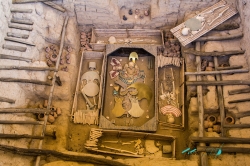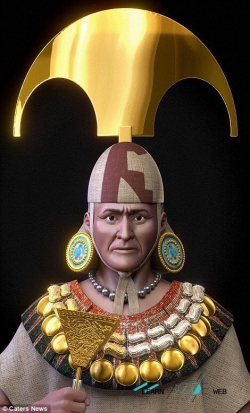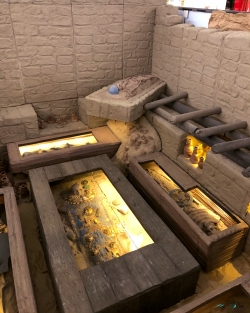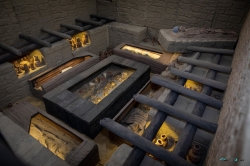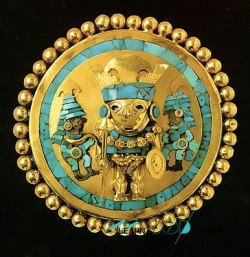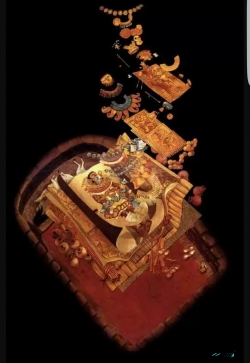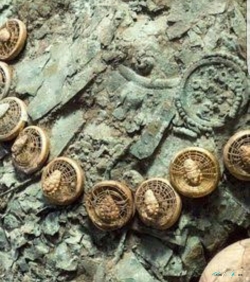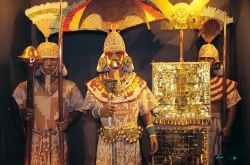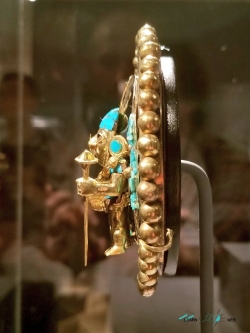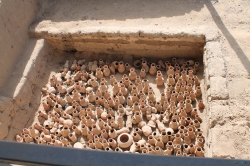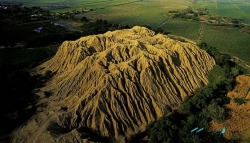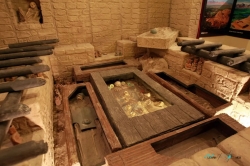Huaca Rajada, also known as Sipán, is a Moche archaeological site in northern Peru in the Lambayeque Valley, that is famous for the tomb of Lord of Sipán (El Señor de Sipán), excavated by Walter Alva and his wife Susana Meneses beginning in 1987. The city of Sipán is dated from 50–700 AD, the same time as the Moche Period.
Sipán is an archaeological site where royal tombs were discovered and excavated between 1987–1990, a fairly recent find in the last 30 years, and is considered to be a very important archaeological discovery. Many of the tombs were looted, yet the artifacts that remained and were discovered by archaeologists play an important role in understanding the Moche rulers and tradition. Tombs have been found also in Sipán's Huaca Rajada, an area near Chiclayo. The tombs in the area are of adobe construction, of pyramidal shape, and have now shown erosion which could have been exacerbated over time by successive El Niño events. There is very little research on the commoners of Sipán, yet it is well known that the commoners often paid a tax through labor which allowed for the creation of the burial platforms for the Lords of Sipán. These platforms and other adobe structures are often made with marked adobe bricks which tracked this labor in order to pay off taxes. Other than providing labor for the Lord there is very little known specifically about Moche commoners from Sipán.
The tombs of Sipán allowed for archaeologists and anthropologists to get a better understanding of the Sacrifice Ceremony of the Sipán rulers that had been illustrated on murals, ceramics, and other decorative goods. The Sacrifice Ceremonies were often depicted with prisoners among gods or royalty. The tombs at Sipán showed that rulers actually took part in such Sacrifice Ceremonies when looking at the artifacts uncovered including: adornments and a headdress that matched the illustrations of the ceremony along with large knives and tools that would have been used for bloodletting and decapitation.
During the excavations in 1987–1990, a spectacular treasure of gold and silver ornamental and ceremonial artifacts was recovered, dating to AD 50–300. These objects demonstrate the outstanding craftsmanship of the Moche metalsmiths through their use of elaborate and advanced metalworking techniques. Moche smiths made these artifacts out of thin sheets of copper alloys, using electrochemical processes to purify an extremely thin (0.5–2.0 μm) layers of gold or silver coating
Sipán is an archaeological site where royal tombs were discovered and excavated between 1987–1990, a fairly recent find in the last 30 years, and is considered to be a very important archaeological discovery. Many of the tombs were looted, yet the artifacts that remained and were discovered by archaeologists play an important role in understanding the Moche rulers and tradition. Tombs have been found also in Sipán's Huaca Rajada, an area near Chiclayo. The tombs in the area are of adobe construction, of pyramidal shape, and have now shown erosion which could have been exacerbated over time by successive El Niño events. There is very little research on the commoners of Sipán, yet it is well known that the commoners often paid a tax through labor which allowed for the creation of the burial platforms for the Lords of Sipán. These platforms and other adobe structures are often made with marked adobe bricks which tracked this labor in order to pay off taxes. Other than providing labor for the Lord there is very little known specifically about Moche commoners from Sipán.
The tombs of Sipán allowed for archaeologists and anthropologists to get a better understanding of the Sacrifice Ceremony of the Sipán rulers that had been illustrated on murals, ceramics, and other decorative goods. The Sacrifice Ceremonies were often depicted with prisoners among gods or royalty. The tombs at Sipán showed that rulers actually took part in such Sacrifice Ceremonies when looking at the artifacts uncovered including: adornments and a headdress that matched the illustrations of the ceremony along with large knives and tools that would have been used for bloodletting and decapitation.
During the excavations in 1987–1990, a spectacular treasure of gold and silver ornamental and ceremonial artifacts was recovered, dating to AD 50–300. These objects demonstrate the outstanding craftsmanship of the Moche metalsmiths through their use of elaborate and advanced metalworking techniques. Moche smiths made these artifacts out of thin sheets of copper alloys, using electrochemical processes to purify an extremely thin (0.5–2.0 μm) layers of gold or silver coating




